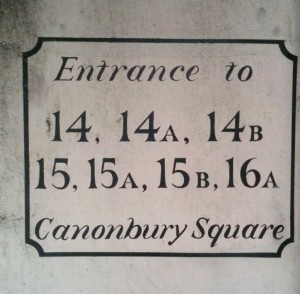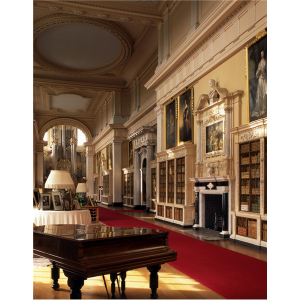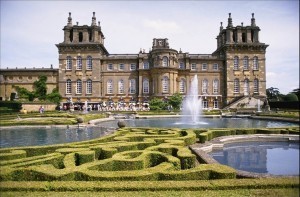Nicola Cornick's Blog, page 27
August 21, 2011
James Patterson's Writing Tips
Here are three writing tips from James Patterson, the bestselling author in the world this year:
1. The story must have a driving force.
2. Individual chapters must hold the attention all the way through.
3. Be there – you need to feel the action. You need to be emotionally engaged with your writing.
©2011 Nicola Cornick. All Rights Reserved.
.August 19, 2011
Canonbury Walk
A few weeks ago I visited a part of North London I didn't know very well and did some historical exploring around  Canonbury.
Canonbury.
Canonbury Square was laid out in 1800, the first square to be built in Islington as residential London spread outwards in the 19th century. It was developed by Henry Leroux and Richard Laycock on land owned by the Marquess of Northampton. It has many beautiful Georgian houses built along clean, classical lines and surrounding a central garden where I was very happy to sit for a while in the sunshine and admire the architecture. Evelyn Waugh (1903-66) occupied 17a Canonbury Square from 1928-1930 and later let it out to fellow writer Nancy  Mitford. George Orwell moved into number 27 in 1944. Some of the houses still have their original numbering painted on the walls, which I was intrigued to see. It is considered one of the finest squares in London and I can see why. It has a great elegance about it.
Mitford. George Orwell moved into number 27 in 1944. Some of the houses still have their original numbering painted on the walls, which I was intrigued to see. It is considered one of the finest squares in London and I can see why. It has a great elegance about it.
After admiring the classical order of the square I went for a walk back in time along the New River. Neither new (it was commissioned in 1604) nor a river (it's an aqueduct) the New River was designed to bring natural spring water from Hertfordshire into Central London as the population of the city increased and so did  the demand for a clean water supply. A covered reservoir was built at the beginning of the 18th century and the amount of water drawn was increased by using a windmill, a windlass driven by horsepower and later a steam engine. The water was then piped into central London in elm pipes. The area around the head of the New River was once a series of pools where fishing and duck shooting took place. When the aqueduct was opened in 1613 there was a huge celebration led by the Lord Mayor of London "at which the flood-gates flew open, the streame ran gallantly into the cisterne, drummes and trumpets sounding in triumphal manner!"
the demand for a clean water supply. A covered reservoir was built at the beginning of the 18th century and the amount of water drawn was increased by using a windmill, a windlass driven by horsepower and later a steam engine. The water was then piped into central London in elm pipes. The area around the head of the New River was once a series of pools where fishing and duck shooting took place. When the aqueduct was opened in 1613 there was a huge celebration led by the Lord Mayor of London "at which the flood-gates flew open, the streame ran gallantly into the cisterne, drummes and trumpets sounding in triumphal manner!"
The aqueduct still supplies water to London and is now a beautiful nature walk which we enjoyed very much.
©2011 Nicola Cornick. All Rights Reserved.
.August 15, 2011
What Lies Beneath
What lies beneath the dust jacket of a book? A couple of weeks ago, the leaders of both the UK Labour and Conservative parties were in the news for their holiday reading. A  photograph captured Ed Milliband, Labour party leader, carrying a pile of holiday books that included such titles as Fault Gap, Prosperity without Growth, The Last Campaign, and Leadership on the Line. Meanwhile it was reported that Conservative MPs had been issued with a book list that included biography, memoirs, historical non-fiction and even (gasp!) a few novels. So far so heavy, both in terms of luggage and reading. None of this, however, takes into account what might be lurking beneath the dust jacket.
photograph captured Ed Milliband, Labour party leader, carrying a pile of holiday books that included such titles as Fault Gap, Prosperity without Growth, The Last Campaign, and Leadership on the Line. Meanwhile it was reported that Conservative MPs had been issued with a book list that included biography, memoirs, historical non-fiction and even (gasp!) a few novels. So far so heavy, both in terms of luggage and reading. None of this, however, takes into account what might be lurking beneath the dust jacket.
Dust jackets were invented in the 19th century, originally to protect expensive books on their journey from the bookseller or binder to the library or home. They began as plain paper wrappings at a time when it was the book beneath that was decorative. There is a splendid article on the evolution of the dust jacket here on the Victoria and Albert Museum website. Over the years though, the dust jacket has become as much disguise as advertisement. Witness the copies of the Harry Potter books with "grown up" covers for those readers who did not want to admit that they were reading a children's book. Then there is my "friend" who wrote gleefully to inform me that she always wrapped my books in plain paper covers so that one one would guess she was reading a – shock, horror! – romance novel!
I suspect that under the covers of the earnest tomes carried by lots of worthy people lurk an entire library of far more exciting and enjoyably escapist reading – romance books, thrillers, crime novels, science fiction and westerns. Perhaps even a copy of Notorious by Nicola Cornick. Who knows…
Today at the Word Wench blog we are talking about heroes and villains; which is easier to write and which we prefer writing. There's the chance to win a book – open to romance readers and fans and worthy tome-ists alike!
©2011 Nicola Cornick. All Rights Reserved.
.August 12, 2011
A Brief History of "P".
Today I am blogging at the Word Wenches on the historical applications of that most versatile and ubiquitous substance, urine! This may not sound very edifying but from the earliest  of times urine has had many useful and beneficial applications and today I am exploring a few of these. Drop in at the Wenches to read all about the making of Harris Tweed and the forging of steel sword blades!
of times urine has had many useful and beneficial applications and today I am exploring a few of these. Drop in at the Wenches to read all about the making of Harris Tweed and the forging of steel sword blades!
©2011 Nicola Cornick. All Rights Reserved.
.August 8, 2011
Conservation in Action at Ashdown House
Today I am playing truant from my writing in order to do some work for Ashdown House. Yes, Ashdown is spreading its wings on the internet. The seventeenth century hunting lodge  now has a twenty first century Twitter account, facebook page and blog, of which I am the curator! This new development is to allow people to follow the major piece of conservation work that we are undertaking at Ashdown over the next year. In a couple of weeks the house will be covered in scaffolding and a temporary roof will be erected. The entire 17th century roof is being replaced and other structural work will be undertaken at the same time. It is a huge and complicated project but it will be so exciting – I can hardly wait to see what stories the house will have to tell us when we can see the beams and the mason's marks and possibly even 17th century graffiti! I will be giving blog and twitter updates on the work so that even if you can't come to Ashdown in person to see the special conservation work you can still follow the progress of the project on the web. There will be reports from our archaeologists, conservators, architects and all the other experts on site. It's a wonderful opportunity to see the conservation work of the National Trust in action. Please follow Ashdown House on Facebook http://on.fb.me/orrjXp, on Twitter @AshdownHouseNT and of course on our special blog at www.ashdownhouse.blogspot.com for all the action!
now has a twenty first century Twitter account, facebook page and blog, of which I am the curator! This new development is to allow people to follow the major piece of conservation work that we are undertaking at Ashdown over the next year. In a couple of weeks the house will be covered in scaffolding and a temporary roof will be erected. The entire 17th century roof is being replaced and other structural work will be undertaken at the same time. It is a huge and complicated project but it will be so exciting – I can hardly wait to see what stories the house will have to tell us when we can see the beams and the mason's marks and possibly even 17th century graffiti! I will be giving blog and twitter updates on the work so that even if you can't come to Ashdown in person to see the special conservation work you can still follow the progress of the project on the web. There will be reports from our archaeologists, conservators, architects and all the other experts on site. It's a wonderful opportunity to see the conservation work of the National Trust in action. Please follow Ashdown House on Facebook http://on.fb.me/orrjXp, on Twitter @AshdownHouseNT and of course on our special blog at www.ashdownhouse.blogspot.com for all the action!
©2011 Nicola Cornick. All Rights Reserved.
.August 3, 2011
Room of the Week!
Can you imagine having a personal library with space for 10,000 books? When I went to Blenheim Palace last week I was in raptures over the Library and wanted to live there (just in  that one room – there would have been plenty of space!) There's a reason why this room is called The Long Library. It's one hundred and eighty feet long and is apparently the second longest room in a private house in England. It runs the length of the West Front of the house and was planned by Vanbrugh and designed by Hawksmoor as a picture gallery. In inclement weather it would double up as a place to promenade. Vanbrugh described it as a "noble room of parade or picture gallery."
that one room – there would have been plenty of space!) There's a reason why this room is called The Long Library. It's one hundred and eighty feet long and is apparently the second longest room in a private house in England. It runs the length of the West Front of the house and was planned by Vanbrugh and designed by Hawksmoor as a picture gallery. In inclement weather it would double up as a place to promenade. Vanbrugh described it as a "noble room of parade or picture gallery."
The ceiling is also magnificent, made of stucco with two false domes. The empty ceiling panels apparently reflect a disagreement with the decorators. Sir James Thornhill was originally commissioned to fill them with allegorical scenes. He proved too expensive so they remained blank, which looks very clean and elegant. At one end of the library is an enormous statue of Queen Anne, erected by the first Duchess of Marlborough to commemorate their friendship. At the other end is the largest pipe organ in private ownership in Europe. Yes, everything at Blenheim is on a grand scale!
In other news today, I am blogging at The Season for Romance on the subject of untying the knot – annulment in the Regency period. It wasn't as easy to get an annulment as people often imagine!
©2011 Nicola Cornick. All Rights Reserved.
.August 1, 2011
Coming Up This Week…
Happy Monday! Today, August 1st, is Yorkshire Day. I'm very proud to be a Yorkshire girl and send you all greetings from my beautiful home county.
It's another busy week here (and it's HOT! Hot weather in England!) Today I am the guest of the lovely people over at My Book Addiction and More and on Wednesday August 3rd I am blogging at The Season for Romance. Finally on Friday I am chatting on the Romantic Novelists Association Blog about the Scandalous Women of the Ton series, writing and life!
Congratulations to all my recent prizewinners! Liz H and Alyssa won over at the Word Wenches blog. Shadow won a copy of Notorious at Lila DiPasqua's fabulous Husband Blog Party and Laura T won on the Fresh Fiction blog. I love giving books away! Here on my own website and blog Alison L won a set of the Scandalous Women of the Ton series and Joan won the gorgeous Irish wool purse and a backlist book. Phew! There will be more giveaways coming soon, especially as I have some goodies from my trip to Blenheim Palace last week.
Thank you all for dropping in and I hope you have a wonderful week!
©2011 Nicola Cornick. All Rights Reserved.
.July 29, 2011
Blogs and Prizewinners!
I'm so grateful to all the people who have invited me to blog lately – I have been having a lot of fun! Today there are two more blogs and two more opportunities to win! Over at the  Word Wenches I am interviewing Katherine Kellgren, who is the narrator for the audiobook version of NOTORIOUS. Katherine gives a fascinating insight into the process of how an audiobook is recorded. Drop by for the chance to win a gift voucher from Audible! Meanwhile over at Fresh Fiction we are discussing ways to be scandalous in the Regency period. Whether it's by eloping to Gretna, driving a racing curricle or travelling the world, there's a signed copy of Notorious up for grabs for one commenter.
Word Wenches I am interviewing Katherine Kellgren, who is the narrator for the audiobook version of NOTORIOUS. Katherine gives a fascinating insight into the process of how an audiobook is recorded. Drop by for the chance to win a gift voucher from Audible! Meanwhile over at Fresh Fiction we are discussing ways to be scandalous in the Regency period. Whether it's by eloping to Gretna, driving a racing curricle or travelling the world, there's a signed copy of Notorious up for grabs for one commenter.
Here on the blog I'll be announcing the winners of both the most recent blog contest and the website contest on Monday. Oh, and to keep this historical, today I visited Blenheim Palace with fabulous author Sarah Morgan and we had a lovely time! More about that in a blog piece coming soon! Have a lovely weekend!
©2011 Nicola Cornick. All Rights Reserved.
.July 26, 2011
One of the Great Institutions of the Equine World
Today is the official launch day for Notorious and I am very excited it is finally here! I'm also guesting over on the blog of the lovely Micole Black, Micole Writes Romance, so do please  drop in to say hello!
drop in to say hello!
Meanwhile, here on this blog I'm indulging my passion for history! As you know, I always enjoy putting some more unusual elements into my books and one of the scenes in Notorious is set at Tattersalls bloodstock agents, a place known as "one of the great institutions of the equine world."
Tattersalls was founded in 1766 by Richard Tattersall, a former groom and trainer to the Duke of Kingston. The firm occupied a very pleasant, almost rural situation behind St George's Hospital close to Hyde Park Corner. It was originally set up in response to the desire in Georgian society for fixed premises where gambling on racing might take place. Many racehorse owners indulged in gambling to fund racehorse ownership because prize money was small. Wagers were conducted on a gentlemanly basis off-course. The founding of Tattersalls gave them a fixed location, an upmarket betting shop. The entry requirements for Tattersalls were socially stringent, asking for good breeding (from the owners as well as the horses) and sound funding. There were two subscription rooms, reserved for the use of members of the Jockey Club, and these became a popular rendezvous for the sporting and betting men.
 Richard Tattersall was also the owner of the legendary racehorse Highflyer, who was foaled in 1774. Highflyer was never beaten in twelve starts on the racecourse and became an outstanding stallion at stud at Highflyer Hall, Richard Tattersalls home near Ely in Cambridgeshire. He was the sire of three Derby winners in the first ten years of the world's most famous race. Tattersall was probably the first thoroughbred breeder to sell his young stock rather than race them and out of this commercial policy grew the beginnings of the present day Tattersalls, specialising in blood stock sales.
Richard Tattersall was also the owner of the legendary racehorse Highflyer, who was foaled in 1774. Highflyer was never beaten in twelve starts on the racecourse and became an outstanding stallion at stud at Highflyer Hall, Richard Tattersalls home near Ely in Cambridgeshire. He was the sire of three Derby winners in the first ten years of the world's most famous race. Tattersall was probably the first thoroughbred breeder to sell his young stock rather than race them and out of this commercial policy grew the beginnings of the present day Tattersalls, specialising in blood stock sales.
Tattersall's other business was as an auctioneer and his premises included stables, loose boxes and a ring for displaying the horses. He presided over the sale of the Duke of Kingston's stud in 1774 and the Prince of Wales's stud in 1786 and the most famous dispersal of them all, that of the Duke of Cumberland where many famous horses were sold. Tattersall was a great friend of Prinny and co-owner with him of the Morning Post, a conservative newspaper, for a number of years. Tattersalls' business continued down the generations of the Tattersall family and is still going strong today.
Here is a description of Regency Tattersalls from a contemporary guide to London:
"TATTERSALL'S, 10 GROSVENOR PLACE, entered by a narrow Lane, at the side of St. George's Hospital a celebrated mart for the sale of horses, and so called after Richard Tattersall, (d.  1795), originally a training groom to the second and last Duke of Kingston. Tattersall acquired the foundation of his fortune by the purchase, for 2500l., of the celebrated horse "Highflyer." All horses for sale must be sent on the Friday before the day of sale. The days of sale are Mondays throughout the year, and Thursdays in the height of the season. Here is a subscription-room, under the revision of the Jockey Club, and attended by all the patrons of the turf, from noblemen down to innkeepers. Days of meeting, Monday and Thursday throughout the year. Settling days, Tuesday after the Derby, Monday after the St. Leger. It is necessary to have an introduction from a subscriber. Annual subscription, 21. 2s. The number of members is stated to be between three and four hundred. The betting at Tattersall's regulates the betting throughout the country."
1795), originally a training groom to the second and last Duke of Kingston. Tattersall acquired the foundation of his fortune by the purchase, for 2500l., of the celebrated horse "Highflyer." All horses for sale must be sent on the Friday before the day of sale. The days of sale are Mondays throughout the year, and Thursdays in the height of the season. Here is a subscription-room, under the revision of the Jockey Club, and attended by all the patrons of the turf, from noblemen down to innkeepers. Days of meeting, Monday and Thursday throughout the year. Settling days, Tuesday after the Derby, Monday after the St. Leger. It is necessary to have an introduction from a subscriber. Annual subscription, 21. 2s. The number of members is stated to be between three and four hundred. The betting at Tattersall's regulates the betting throughout the country."
To celebrate the release of Notorious today I am offering a special blog prize to one commenter of a copy of one of my backlist books (your choice) and a beautiful Irish wool purse (in honour of Notorious's Irish hero!) My question – if you could have taken part in or watched a Regency sport, which one would you have chosen? Would you have enjoyed being a racehorse owner or would you have gone to see the Regency boxing, or fencing or some other sport?
©2011 Nicola Cornick. All Rights Reserved.
.July 22, 2011
Two fun blogs!
 Today, as promised, Mr Cornick is taking his first steps in blogging with a guest appearance at the fabulous Husband Blog Party hosted by Lila DiPasqua's wonderful hubby Mr DiPasqua. Mr Cornick had a great deal of fun with this interview and has already been enjoying the comments so please do drop by to chat with him! Who knows, this could be the first step in a new venture for Mr C into social networking!
Today, as promised, Mr Cornick is taking his first steps in blogging with a guest appearance at the fabulous Husband Blog Party hosted by Lila DiPasqua's wonderful hubby Mr DiPasqua. Mr Cornick had a great deal of fun with this interview and has already been enjoying the comments so please do drop by to chat with him! Who knows, this could be the first step in a new venture for Mr C into social networking!
Meanwhile over at Romantic Times I am blogging about Susanna, the heroine of NOTORIOUS, and her unusual profession of match-breaker. Please drop by to see which famous couples from history Susanna might have had a go at splitting up!
©2011 Nicola Cornick. All Rights Reserved.
.


